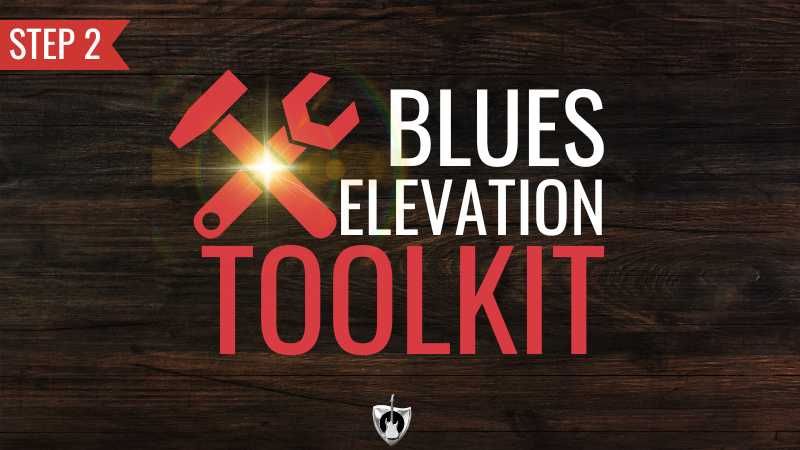Guitar Scales: The Five Pattern System

- How the fretboard is set up
- What Scales Are and How They're Built
- Best Scales for Popular Music
- The Five Pattern System
- Soloing Over Chords
- Playing Scales in Different Keys
(You’re currently reading Step 4 of 6)
Learning scale patterns on the guitar can be tough!
Most guitar players who come to me for help already know one or two pentatonic scale patterns. Usually it’s the Minor pentatonic pattern one scale, you know the “blues box” pattern.
What started as pure joy when you first played this pattern over a blues or rock background track, has slowly turned into frustration. Knowing just this one pattern will get you up and running but you soon find out it is not enough.
As you progress in the songs you choose to learn, or with the band members you play with, you start to feel very limited.
It may be that that pattern won’t give you the notes you need to play a certain song, or you feel everything you play is starting to sound the same.
Or, it could be that the notes in that pattern just don’t match the songs and the styles that you are trying to play.
It becomes obvious that there is a lot more to learn.
You look at all of those places on the guitar that you aren’t using and you quickly become overwhelmed.
“Where do I go from here?”
Unfortunately, this is one of the toughest stops on the journey of mastering the guitar. Most players get frustrated and settle for the “blues box”.
How do I know this situation so well? Not only do I help players break through this “brickwall” on a weekly basis, but I have gone through this myself and come out the other side.
Here’s how:
After I had been playing guitar for a few years, I got the courage to join a band! It was just what you might think: a bunch of guys playing way too loud and having a lot of fun.
I knew the “blues box” and I was ready to start playing some lead.
We played a few covers and I learned the lead parts from tablature. These sounded great but I didn’t know why they worked so well.
I had just memorized the fret numbers from the tabs. These guitar solos definitely didn’t sound like the pentatonic scale pattern I knew.
Over time, we started writing our own songs. That’s when it really hit home.
The guitar solos that I came up with didn’t sound anywhere near as good as the cover songs I had memorized.
I needed to be able to get different sounds and play in different places on the guitar. I needed help and I started asking a lot of questions to my guitar player friends.
I’m glad I did and I’m going to share what I learned with you here today.I needed to know how the guitar actually worked.
By just knowing one scale pattern, It was like trying to drive a car with a flat tire. Sure the car will move forward, just not very fast. And, trying to get were you want to go is almost impossible.
If I had made learning scale patterns over the neck a priority right from the start, things would have been different. So lets take a look at how we can make that happen, starting today!
INTRODUCTION TO SCALE PATTERNS
We have now made it to step four of my six step plan on “The best way to learn guitar scales”, which is:
- Understand how the fretboard is set up
- Understand what scales are and how they are built
- Know the best scales to learn for your style of music
- Break those scales into manageable patterns
- Start playing those patterns over chords
- Slide those patterns into different keys
If you haven’t read the first two posts in this series, I suggest you do so now. These two posts go through steps 1-3 and will give you the information you need to move forward with the patterns we are going to cover today.
Now on to step four!
Step four takes our knowledge of how scales are built and what scales to use for popular music and moves one step further. We are going to learn the scale patterns for the “big four” scales…
- Major
- Natural minor
- Major pentatonic
- Minor pentatonic
…And learn how to play them across the fretboard.
WHAT ARE SCALE PATTERNS
Now that we have learned what the notes are on the fretboard and what notes we need to play our scales, things quickly get overwhelming.
Just playing scales up and down a single string like we did in the last post takes a lot of movement and effort.
The next step is to learn how to play these scales in one position (playing the notes across the neck,in one area of the guitar without having to move your hand around).
The nice thing about how the guitar works is that these scales create patterns across the guitar that we can use in every key, just by sliding them into different postions on the neck!
THE OPEN POSITION
Most beginners, if they learn any scales at all, learn the major scale in what is called the open position. This is the area on the guitar that is closest to the nut. I teach this as well.
Once a beginning student has a firm grip on the open positions chords, I like to show them the major scales right where those chords are.
For open position scales you have to learn a different pattern for each key. If you have ever taken piano lessons, it is like that. Every key has a different pattern.
Learning those patterns are fun for the beginning student and can get you started reading music.
Here are a few Major scale patterns in open postion:

Being limited to just the first few frets of the guitar is fine in the beginning. It doesn’t take long before a new student is ready to explore new territory!
FIVE PATTERN SCALES
This is where the magic happens!
Learning your scales in five different positions opens up a new world for lead guitar! The five pattern system spreads scales all over the fretboard.
Where in open position patterns we had to learn a new pattern for each key, using scale patterns in five positions is set up a little different.
All we have to learn is five patterns for each scale. One pattern for each of the five main areas on the guitar. They sit one after another and go in order.
What happens once you work your way through from pattern one to pattern five. Where do you go next?
After pattern five, the next higher pattern is pattern one again. They go in a circle:
1,2,3,4,5,1,2,3,4,5 until you run our of frets.
If you are going the opposite direction, from high to low, it works the same way. Pattern five is always lower than pattern one:
5,4,3,2,1,5,4,3,2,1
For now, I will give you all of these pattern in the key of A. These patterns work for all keys, but the key of A is the easiest to visualize.
A MAJOR SCALE IN 5 PATTERNS
Take a look at all five of the A Major scale patterns below.

Notice that the fingering is given for each pattern and the tonic note is highlighted in red.
Pay special attention to where the tonic notes are. We will need these later when we start playing these scale in different keys.
- Incorporate each of these scale patterns in your daily practice. Play them up and down at first.
- Then when you are confident, put on an A major backing track. Play them along with the track and listen to how the notes relate to the chords being played.
I generally introduce one pattern per week with my small group students. I find spending a week with each position gives plenty of time to get familiar with each pattern.
A MINOR SCALE IN FIVE PATTERNS
Take a look at the image below.

Did you notice anything? The patterns look the same!
“Are you telling me that I don’t have to learn a whole new set of patterns to play the minor scale”.
You betcha!
Take a look at pattern one. The fingering is the same as pattern one of the Major scale with two important differences:
- Pattern one of the Major scale started at the second fret and pattern one of the minor started at the fifth. And…
- The tonic note in the Major scale started with the fourth finger on the low string, but the tonic note on the minor started with the first finger
Try practicing this scale the same way as the Major scale. Play each pattern up and down. Then try over an A minor backing track. I suggest spending a good bit of time with each position before moving on to the next.
A MAJOR PENTATONIC IN FIVE PATTERNS
In the last post we learned that the pentatonic scales are just slimmed down versions of the the full Major and minor scales. Two notes are removed.
Lets take a look below at the A Major pentatonic patterns in five postions.

Did you notice anything with this one?
One of the patterns should look familiar. That’s right, pattern one looks an awful lot like the “blues box”.
Well that’s because it is!
But take a look at all of those other patterns. If you only knew the “blues box”, you are only getting 1/5 of what you need from this scale.
Also, pay special attention to where the tonic notes sit with these.
A MINOR PENTATONIC IN FIVE PATTERNS
Finally, lets take a look at the minor pentatonic scale:

This should look familiar as well. All of these patterns are exactly the same as the Major pentatonics except for two things.
Take a look at pattern one. It just:
- Starts at different fret. And…
- The tonic note is on the first finger instead of the the fourth
Practice the Major and minor pentatonic scales the same way as the full Major and minor scales. One position at a time. When you are ready, try a blues background track in the key of A for some fun!
CONCLUSION
As you can see, really understanding scale patterns on the fretboard is not impossible. Being comfortable with just five patterns per scale opens up a new world of playing guitar.
Trying to change the way you are used to playing is always challenging, but this change will really pay off and will definitely take you to the next level of your journey on the guitar!
Stay tuned for the next few posts where we will take these scales and start playing them over chords and moving them into new keys!
CLICK HERE to move on to Step #5
GET FREE WEEKLY GUITAR LESSONS, PODCASTS, AND MOTIVATION DELIVERED TO YOUR INBOX.
Your information is kept safe. It's never shared with third parties.







